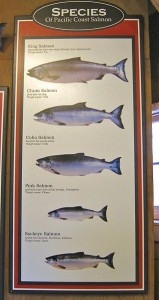
Pacific salmons are well-known examples of anadromy. They live most of their lives at sea but spawn in fresh water
An anadromous fish hatches and spawns in fresh water but spends most of its life in the salt water. This dual life cycle allows the younger fish to grow and feed in the less perilous fresh water habitats (fewer predators in the smaller systems) and the older, larger fish to grow and feed in the marine systems, where there is a greater prey base. Migrating between fresh and salt water requires complex osmoregulatory adaptations. Some species, such as Pacific salmons, only transition between fresh and salt water twice, migrating to salt water early in life and then migrating back to freshwater to spawn once and die (a semelparous reproductive strategy). Other species, such as Striped Bass (Morone saxatilis) will migrate between fresh and salt water every year to spawn (an iteroparous reproductive strategy).
For more information, check out the “CAN YOU SAY ANADROMOUS, CATADROMOUS, AMPHIDROMOUS, OCEANODROMOUS, OR POTAMODROMOUS?” post on The Fisheries Blog!

